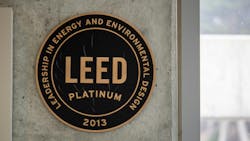Best Practices for Navigating the New LEED v5 Reality
Key Highlights
- LEED v5 emphasizes decarbonization as a core metric, requiring projects to reduce operational and embodied carbon for certification.
- New prerequisites include climate resilience, social impact, and occupant needs assessments, fostering holistic sustainability and community wellbeing.
- High-level certification like LEED Platinum now demands full electrification, renewable energy sourcing, and significant embodied carbon reductions.
- Early planning, adopting new workflows, and integrating holistic carbon strategies are essential for navigating the complexities of LEED v5.
- The transition to LEED v5 will drive industry-wide innovation, promoting sustainable practices that benefit both the environment and building occupants.
Since 1998, the US Green Building Council’s (USGBC) Leadership in Energy and Environmental Design (LEED) standards have served as a globally recognized certification system. As the most widely used green building certification system in the world, LEED is a shifting standard that pushes the industry forward by raising the bar on innovation with each new iteration.
The latest LEED standard released this summer, LEED v5, has profound implications for general contractors, architects, developers, and other stakeholders in the building process. Broadly, it aims to further advance sustainability, decarbonization, and ecological conservation.
The changes are significant. So are the opportunities for innovation and impact.
What’s New in LEED v5
LEED v5 is structured around three core impact areas:
- Decarbonization: This is the most heavily weighted area, emphasizing the reduction of carbon emissions across the building’s lifecycle. This includes operational carbon, embodied carbon in materials, and emissions from transportation and refrigerants.
- Quality of Life: This area focuses on the health and wellbeing of building occupants and the surrounding community. It includes credits for indoor air quality, access to daylight, and social equity.
- Ecological Conservation and Restoration: This new area encourages projects to contribute to the restoration of ecosystems and to select sites that minimize environmental harm.
The single biggest change in LEED v5 is that addressing carbon is no longer optional, making it a core metric and required component of certification. This is a positive step toward fully understanding the impact of materials, promoting increased transparency, and making an important improvement in how teams source and manage their materials.
Every LEED v5 credit is directly connected to decarbonization goals, which in turn tangentially benefit communities’ quality of life and promote ecological conservation and restoration.
LEED v5 also introduces several new prerequisites, including:
- Climate Resilience Assessment: All projects must conduct a climate resilience assessment to identify and plan for climate-related risks, such as extreme weather events and rising temperatures.
- Social Impact Assessment: This prerequisite promotes social equity by requiring an analysis of the project’s impact on the community.
- Occupant Needs Assessment: This aims to better understand the needs of the building’s occupants.
LEED v5 also introduces new requirements for LEED Platinum, the highest level of LEED certification, which requires projects to meet specifications for decarbonization thresholds, including high levels of energy efficiency, an all-electric design, on-site renewable energy, and reductions in embodied carbon.
Notably, the standards are not the only thing changing, and project stakeholders will need to account for numerous other, more minor changes.
The time horizon for their development is also becoming more concrete. The USGBC has announced that LEED will move to a five-year development cycle to ensure the rating system remains current with industry practices and challenges.
How to Achieve LEED v5 Certification
LEED v5 introduces some complexity, and teams must be prepared for new workflows and higher standards. Here are three best practices for achieving LEED v5 certification.
1. Implement Holistic Carbon Planning
Forward-thinking carbon planning is foundational for LEED v5 certification. This includes accounting for carbon planning in the building performance and the construction materials themselves.
To earn certification, project teams must develop a visual representation of future carbon emissions, illustrating how annual carbon emissions are expected to decrease over time due to the decarbonization of most electric grids.
Further credits are then awarded for decarbonization achieved through three critical steps: electrification, reduction of peak thermal loads, and increased energy efficiency.
However, LEED v5 certification isn’t just focused on operations. It also incorporates the embodied carbon, the emissions generated during the extraction, manufacturing, transportation, installation, and disposal of products.
As embodied carbon from building materials accounts for at least 11% of annual global emissions, LEED v5 targets strategies for high-impact actions, such as decarbonizing the supply chain, selecting low-embodied carbon materials, and building reuse, to help project teams achieve meaningful carbon reductions immediately.
New prerequisites now require the embodied carbon analysis of at least a project’s structure, enclosure, and hardscape, with additional points being awarded for demonstrating a reduction in embodied carbon. Early planning to identify low-carbon products will be crucial to earning LEED certification.
2. Pay Attention to Product Specifications
Product specifications are becoming both simpler and more complex.
Identifying sustainable materials has been streamlined to a single credit, rather than spanning five different credits. However, to comply, products need to demonstrate multiple sustainability attributes. This means advanced research will be required to successfully roadmap a project strategy, especially as teams seek higher levels of LEED certification.
3. Design with Purpose
The bar for LEED Platinum has been raised—considerably. For owners and project teams seeking LEED’s highest level of certification, significant upfront planning will be required.
Teams aren’t going to luck into Platinum. Buildings must meet all prerequisites and earn a minimum of 80 points (the previous standard), but they now also have to hit specific credit achievement requirements.
Projects must be designed to be 100% electrified (meaning no or extremely limited on-site fuel combustion), achieve a minimum 15% building energy reduction (from the latest energy code), source 100% of site energy use from any combination of Tier 1, Tier 2, and Tier 3 renewable energy, and reduce embodied carbon materials by at least 20%.
Preparing for the Future, Today
As with each new update, expect LEED v4 and v4.1 to dominate for several years. As the industry transitions into LEED v5, teams will need increased coordination to consider how their projects will meet the new requirements. Early planning and adopting new tools and workflows are critical for success and for shortening the learning curve.
The evolution to LEED v5 will be challenging. But with diligence and planning, the new standards provide our industry with guardrails to drive the necessary, impactful change that will redefine construction’s impact for a new era.
About the Author

Tommy Linstroth
Tommy Linstroth is the founder and CEO of Green Badger, a leading SaaS provider simplifying sustainability and ESG in the built industry.
